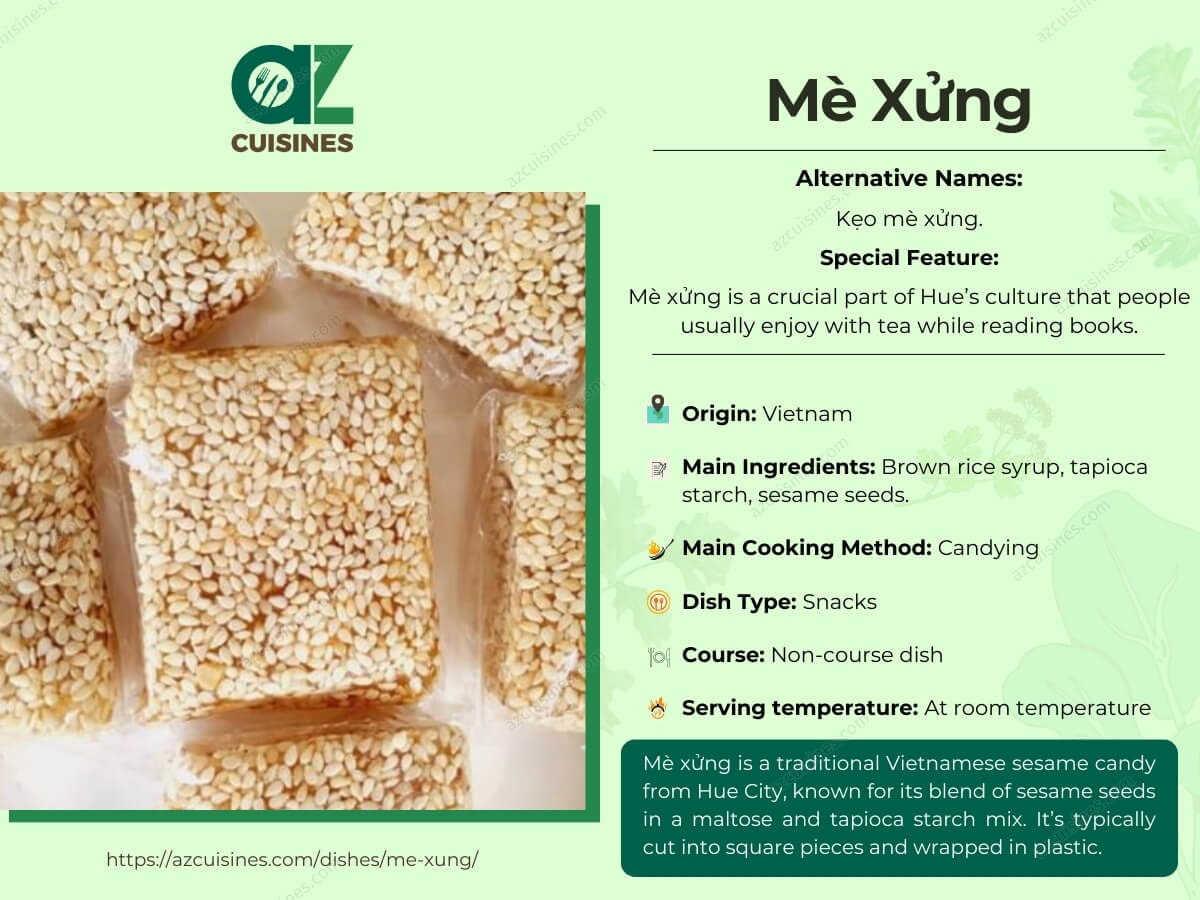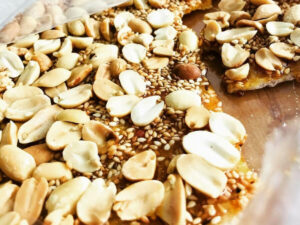#135 in Vietnam
Popular Mè Xửng Variations

Mè Xửng Giòn

Mè Xửng Gương

Mè Xửng Đen
Mè Xửng: Ingredients and Preparation
Main Ingredients
Main Cooking Method
Preparation Process
Mè Xửng: A Deep Dive
Cultural Significance
Taste
Texture
Aroma
Color
Serving Style
Serving Temperature
Accompaniment
Occasions
Seasons
Special Diets
Calories
Popularity
Popular Similar Dishes
- Kẹo Gương
- Cu Đơ
- Chè Lam
Popular Dining Area
Mè xửng, commonly known as kẹo mè xửng, is a traditional Vietnamese sesame candy that originates from Hue City in Central Vietnam. This candy is a simple combination of peanuts and sesame seeds wrapped around a candy mix of maltose with tapioca starch.
Typically, this candy is cut into square pieces and wrapped in plastic wrappers. Thanks to the maltose, the candy has a certain flexibility, being able to return to its original shape after bending. Alternatively, the crunchy version, known as mè xửng giòn, has less sugar content and is covered with a layer of grilled rice crackers.
As a specialty of Hue, tourists often purchase mè xửng as a gift. In Hue, the population even has a tradition of pairing mè xửng with tea while reading books at the same time.
Explore some of the popular versions of mè xửng before finding out the process of creating this candy. Then, don’t miss exploring the pros and cons of consuming mè xửng, along with common inquiries related to it. Also, you should explore some more dishes that are similar to mè xửng.
Key Points
Mè Xửng Images
What Are the Variants of Mè Xửng?
Mè xửng offers various versions simply by adjusting the ingredient composition. Here are 3 common variations of this sweet treat:

Mè Xửng Giòn
Features a crispier, crunchier texture
Has less sugar than the chewy version

Mè Xửng Gương
Known for its glossy, shiny appearance

Mè Xửng Đen
Made with black sesame seeds
Offering a distinct flavor and darker color
Then, explore the process of bringing mè xửng to life by Vietnamese locals using interesting cooking procedures.
How Mè Xửng Is Made?
Mè xửng is made differently depending on the elements that contribute to this sweet candy. For that, let me introduce you to a general process of making mè xửng:
Step 1: Ingredient Preparation
Gather sesame seeds, peanuts, maltose, tapioca starch, and any additional flavorings or ingredients specific to the recipe.
Step 2: Roasting Sesame Seeds and Peanuts
Roast the sesame seeds and peanuts separately until they are golden brown. This enhances their flavor and crunchiness.
Step 3: Making the Candy Base
Cook maltose with a little water and tapioca starch over medium heat. Stir continuously until the mixture becomes thick and transparent.
Step 4: Combining Ingredients
Once the candy base is ready, mix in the roasted sesame seeds and peanuts. Ensure they are evenly distributed throughout the candy mixture.
Step 5: Shaping the Candy
Pour the hot mixture onto a flat, greased surface or into a mold. Flatten it to the desired thickness.
Step 6: Cutting and Wrapping
Once slightly cooled and solidified, cut the candy into square or rectangular pieces.
Step 7: Cooling and Setting
Allow the candies to cool completely at room temperature. This step is crucial for the candy to set and develop the right texture. Wrap each piece in plastic wrap to preserve freshness and prevent sticking.
Also, make sure you don’t miss the benefits and drawbacks that this candy offers, especially when you’re looking to get mè xửng for your next trip to Vietnam.
Pros and Cons of Eating Mè Xửng
When you’re looking to consume mè xửng, make sure to consider these features closely:
Pros
Cons
Next, find out what are some of the common concerns that people often have about mè xửng.













Truc Tran (Kris)
Senior Food Editor
Expertise
Home Cooking, Meal Planning, Recipe Development, Baking and Pastry, Food Editor, Cooking-video Maker, Vietnamese Food Evaluation Expert
Education
Truc Tran (Kris), an experienced food writer and editor, is great at exploring and describing global cuisines, from simple street food to fancy dining. In her writing, she skillfully mixes different flavors, cooking methods, and culinary traditions, showing the unique character of various cultures through their food and drinks. On azcuisines.com, Kris highlights her knowledge, especially in Asian cuisine and worldwide traditional dishes.